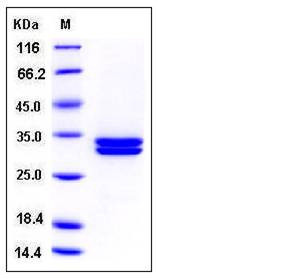Human KLK7 / PRSS6 Protein (His Tag)
hK7,PRSS6,SCCE
- 100ug (NPP4043) Please inquiry
| Catalog Number | P10416-H08H |
|---|---|
| Organism Species | Human |
| Host | Human Cells |
| Synonyms | hK7,PRSS6,SCCE |
| Molecular Weight | The secreted recombinant human KLK7 comprises 242 amino acids and has a predicted molecular mass of 26.7 kDa. As a result of glycosylation, the apparent molecular mass of rh KLK7 is approximately 30-33 kDa in SDS-PAGE under reducing conditions. |
| predicted N | Glu 23 |
| SDS-PAGE |  |
| Purity | > 97 % as determined by SDS-PAGE |
| Protein Construction | A DNA sequence encoding the human KLK7 (NP_005037.1) extracellular domain (Met 1-Arg 253) was expressed, with a C-terminal polyhistidine tag. |
| Bio-activity | Measured by its ability to cleave the fluorogenic peptide substrate, Mca-RPKPVE-Nval-WRK (Dnp) NH2, R&D Systems, Catalog # ES002. The specific activity is >150 pmoles/min/μg. (Activation description: The proenzyme needs to be activated by Thermolysin for an activated form) |
| Research Area | Immunology |Inflammation / Inflammatory Mediator |Plasma Cascade Systems in Inflammation |Fibrinolysis System |
| Formulation | Lyophilized from sterile PBS, pH 7.4 1. Normally 5 % - 8 % trehalose, mannitol and 0.01% Tween80 are added as protectants before lyophilization. Specific concentrations are included in the hardcopy of COA. |
| Background | Kallikrein-7, also known as kallikrein-related peptidase 7, Stratum corneum chymotryptic enzyme, Serine protease 6, KLK7, and PRSS6, is a secreted protein which belongs to the peptidase S1 family and Kallikrein subfamily. Members of the Kallikrein family are involved in various malignancies such as prostate (PSA, KLK2, KLK15), ovarian (KLK4, KLK5, KLK6, KLK8, KLK10), and breast cancer (KLK10, KLK13, KLK14). Kallikrein-7 / KLK7 appears to be increased in ovarian cancer and higher KLK7 expression in ovarian cancer tissue is associated with poorer prognosis of ovarian cancer patients. Kallikrein-7 / KLK7 is abundantly expressed in the skin and is expressed by keratinocytes in the epidermis. Kallikrein-7 / KLK7 is up-regulated in ovarian carcinoma, especially late-stage serous carcinoma, compared with normal ovaries and benign adenomas (at the protein level). It was significantly associated with shorter overall survival (OS) and disease-free survival (DFS). Kallikrein-7 / KLK7 may catalyze the degradation of intercellular cohesive structures in the cornified layer of the skin in the continuous shedding of cells from the skin surface. KLK7 also plays a role in the activation of precursors to inflammatory cytokines. |
| Reference |
